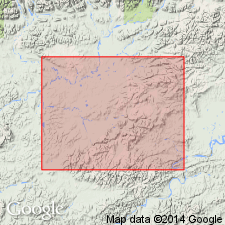
- Usage in publication:
-
- Kanuti series*
- Modifications:
-
- Named
- Dominant lithology:
-
- Basalt
- Greenstone
- Tuff
- AAPG geologic province:
-
- Alaska West-Central region
Summary:
Kanuti series occurs for 30 mi in canyon walls of Kanuti River which later becomes tributary to Koyukuk River, west-central AK. Series includes ultra basic igneous rocks (basalts, basaltic tuffs), tuffs and alteration products (serpentines), some doubtful greenstones and hornstones. Cut by two or three belts of granitic rock. Age is probably Paleozoic based on correlation.
Source: GNU records (USGS DDS-6; Menlo GNULEX).

- Usage in publication:
-
- [Kanuti series]
- Modifications:
-
- Not used
- AAPG geologic province:
-
- Alaska West-Central region
Summary:
Rocks [of Kanuti series] are here mapped as informal lithic units. Early exploratory survey by Mendenhall (1902) is mentioned as containing only abbreviated accounts of the geology of Kanuti River region.
Source: GNU records (USGS DDS-6; Menlo GNULEX).
For more information, please contact Nancy Stamm, Geologic Names Committee Secretary.
Asterisk (*) indicates published by U.S. Geological Survey authors.
"No current usage" (†) implies that a name has been abandoned or has fallen into disuse. Former usage and, if known, replacement name given in parentheses ( ).
Slash (/) indicates name conflicts with nomenclatural guidelines (CSN, 1933; ACSN, 1961, 1970; NACSN, 1983, 2005, 2021). May be explained within brackets ([ ]).

